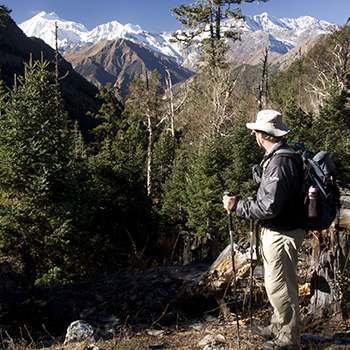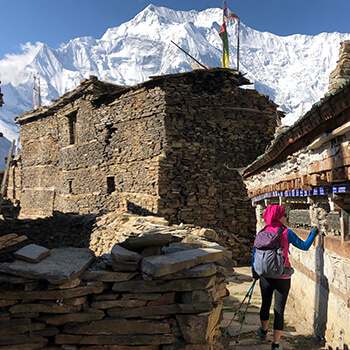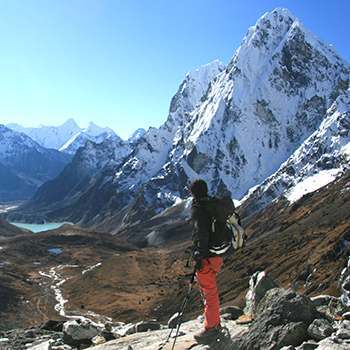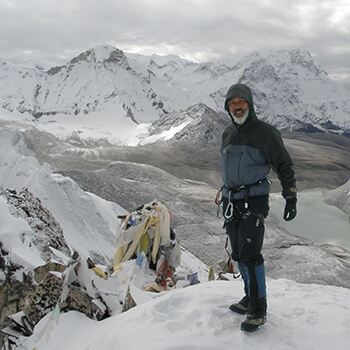Himalayan Festivals and Faiths
The other major factor to consider when deciding to visit the Himalaya is the festival calendar. There are more than 365 festival days just in Nepal, so there is always something happening somewhere! Almost all Himalayan festivals and faiths are related to phases of the moon in some way and do not occur on specific Gregorian calendar dates.
It is a good idea to avoid travelling on some of the main festival days such as Dashain (aka Dasain, Dussehra) or Tihar, as transport systems tend to suffer from overcrowding and delays. You should also be aware that some festivals traditionally require the slaughter of a goat and/or payment of a cash amount, and that visitors are expected to contribute. If you are unsure of the potential impact of a festival to your plans it’s a good idea to consult with locals and be prepared for your plans to change a little.
For further information see:
NEPAL FESTIVALS: www.visitnepal.com or www.qppstudio.net (navigate to the Nepal page).
BHUTAN FESTIVALS: www.tourism.gov.bt/announcements/tentative-festival-dates-2019
INDIA FESTIVALS: www.india.gov.in/calendar

Nepal, Bhutan and India are a complex sacred landscape, full of Himalayan Festivals and Faiths
HINDUISM
Over 85% of Nepali people are Hindu, a religion that dates back to 1500bc. Hinduism has thousands of deities, but there are three main gods: Brahma the creator, Vishnu the preserver and Shiva the destroyer. Most Hindus are Vaishnavites (followers of Vishnu) or Shaivites (followers of Shiva). Popular gods/goddesses are also Ganesha (the elephant-headed god who is the remover of obstacles), Laxmi (goddess of wealth), Saraswati (Brahma’s consort and goddess of wisdom), Hanuman (the monkey god who symbolises strength and protects against accidents), Kali or Durga (the blood-drinking consort of Shiva and goddess of change and death), and Krishna (an avatar of Vishnu), the blue-skinned cowherd who had a penchant for milkmaids and is usually depicted with his flute.
Hindus believe in reincarnation and that the circumstances of your rebirth are determined by your deeds in the present life. The caste system is an important part of Hindu culture in Nepal, but its influence is less noticeable in the major cities. The highest caste is Brahmin (usually priests or civil servants), followed by Chhetri (warriors and rulers), Vaisyas (traders and farmers) and Shudras (artisans). Below this are the Dalits (untouchables) who traditionally have performed menial tasks such as sweeping, butchering and tailoring.
See GHT Ethnic Groups for more info.

Hindu festivals follow the lunar calendar
- Maghe Sankranti is to worship the god Vishnu. It is held for one day in all Hindu communities during mid January.
- Shree Panchami celebrates the birthday of Saraswati, the Goddess of Learning and is combined with Martyr’s Day all over Nepal; held on one day in late January/early February.
- Maha Shivaratri celebrates the god Shiva. The focus of celebrations is Pashupati Temple in Kathmandu where very large crowds pack the temple for days. It is also celebrated at most Shiva shrines in Nepal during February.
- Holi, or Fagun Purnima, is a week-long festival culminating in a spectacular day of coloured water and paint fights. One of the most popular festivals for locals and tourists alike and celebrated in all Hindu communities in late February or early March.
- Bhairav Kumari Jatra celebrates the gods Bhairav and Kumari at Dolka and Bhairav Kund. Held for five days in late July/early August.
- Gai Gatra (Cow Festival) allows any sort of joke, or prank, to be played on someone, but is traditionally in honour of Yamaraj, the god of death. Held for one day in all Hindu communities during August/September.
- Krishna Janmastami celebrates the birth of the god Vishnu. Held for one day during August/September in all Hindu communities that have a Vishnu shrine. This festival is also celebrated as Gaura Parva for two days in west Nepal at about the same time.
- Teej is a married women’s festival to honour the god Shiva. Held at all Shiva and Parvati shrines across Nepal during September.
- Dashain, or Dasain, is the largest festival in the Nepali calendar and celebrates the goddess Durga. Held for 15 days in all Hindu communities during October/November.
- Tihar, Diwali or Deepawali, is the festival of lights to honour the goddess Laxmi (the Goddess of Wealth). It is held for five days and ends with Bhai Tikka (the brother/sister festival) in all Hindu communities during October or November.
- Bibah Panchami celebrates the marriage of the god Ram to Sita and is held for seven days all over Nepal during December.
BUDDHISM AND BON
Buddhism
Buddhism is the second most popular belief system in Nepal and is dominated by Tibetan monasteries, or gompas, of four major sects called Nyingmapa, Kagyupa, Sakyapa and Gelugpa. The Dalai Lama is the head of the Gelugpa sect and their gompas normally boast a large statue of the sage Tsong Khapa who re-introduced Buddhism to Tibet in the 14th century. The Buddha was born in Lumbini in the Nepal terai, the plains along the southern India–Nepal border, in 560bc as a prince, and renounced his worldly possessions to find the ‘middle path’ – the way to enlightenment not through suffering or excess, but by realising that desires lock people into the cycle of suffering and rebirth.
Although Buddhism does not have gods as such, their gompas are decorated with figures depicting certain good or bad characteristics, such as hungry ghosts with tiny necks who were greedy people in a former life, or Buddhas with particular characteristics, or scary-looking temple protectors to keep away evil spirits. Each sect has its own practices and traditions, and the Newar people have combined Hindu and Buddhist beliefs to form a complex religion called Newar Vajrayana Buddhism. The World Heritage listed temples of Boudhanath and Swayambunath are the main Buddhist sites in the Kathmandu valley.
You will frequently hear Buddhists chanting throughout the day, and especially while walking clockwise around a place of worship. The most popular chant is Om MaNi PadMe Hum, a common translation being, ‘Hail! The Jewel in the Lotus.’
Bon
The Bon religion was historically confined to Tibet and surrounding areas such as Dolpo, Sichuan, Yunnan, Bhutan and Assam, and is a combination of Buddhism with older animistic and shamanistic beliefs. Although many of its tenets melded with Buddhism, Bon is distinctly different in its day-to-day practices. There are very few Bon gompas remaining in Nepal; most of them are in Upper Dolpo. People who follow Bon are called Bon Po.
The most obvious differences between Bon and Buddhism are: Bon followers go around chorten (memorial or decorated cairns built on passes, ridges, or other significant spots) and monasteries counter-clockwise (keeping the object on their left side) whereas Buddhists keep the building on their right and go clockwise, the power symbol of Bon is a left-facing swastika (Hindus use a right-facing swastika), whereas Buddhists use the dorje (thunderbolt). The original Bon religion was mostly based on magic, spirits and blood sacrifice to propitiate the gods, who live in all natural things. Bon followers also chant throughout the day, the most common being, Om Matri MuYe SaLe Dhu, which means much the same as the Buddhist mantra.
For more info on Buddhist and Bon, see GHT Ethnic Groups.
Buddhist festivals follow the lunar calendar
- Lhosar, Buddhist New Year, is held for one day in all Buddhist communities the day after the new moon appears during February.
- Teeji is a spring festival and a ritual-cleansing ceremony. Held for four days in Lo Monthang, Mustang during late April to mid May.
- Buddha Jayanti (Buddha’s Birthday) is focused at Lumbini and all major Buddhist places of worship. Held for one day in all Buddhist communities on the full moon night in May/June.
- Tamu Dhee is a ritual cleansing festival to protect homes and fields owned by Gurung communities. Held for one day during August.
- Gunla is a month-long festival to celebrate the beginning of the monsoon and when Buddha led his disciples into a month-long teaching retreat. Held in most Buddhist communities during July/August.
- Mani Rimdu is held for four days in the Everest region. The festival at Tengboche is held in mid October, and at Thame in May.
Teeji festival in detail
The Teeji (comes from the words ‘ten che’, meaning the hope of Buddha Dharma) festival is a three-day ritual known as ‘The Chasing of the Demons’, which centres on a local myth that tells of a deity named Dorje Jono, who must battle against his demon father (Dorje Sonnu) to save the Kingdom of Mustang from destruction. The demon father wreaked havoc on the Kingdom by creating a shortage of water (a precious resource in this very dry land), which caused all sorts of disasters including famine and animal loss. Dorje Jono eventually beats the demon and banishes him from the land, and the community is saved from a plague of misfortunes. Of course, the local population celebrates their salvation, as water will be plentiful again, and the balance and harmony of day-to-day life is restored.
Over three days, the lamas from Chhoede Gompa enact battles and folklore scenes through intricate mask-dances, which culminate in a fireworks and musket-firing melée outside the main gate of the city. Each of the three evenings, there is a cultural programme in the centre of the city, where young and old come to enjoy dance and singing performances. Teeji is a lively, vivid and amusing celebration and reaffirmation of a myth said to have been bought to Mustang by Padmasambhava in the 8th century. Apart from the symbolic ritual of cleansing the Kingdom, Teeji coincides with the end of the dry winter/spring season and ushers in the wetter monsoon season (the growing season in Mustang). So for everyone in Mustang, it is a ‘must-see’ event, where locals dress up in their finery and have a good time.
Temple and Shrine Etiquette
- Many temples are closed for periods throughout the year and you should check if the ‘key-holder’ is nearby otherwise you might have a pointless walk. Personal contact is frowned upon, so you should avoid touching monks or nuns at all times. You should ask if it is necessary to remove your footwear when entering any religious building. Both men and women should have their chests and shoulders covered at all times, whereas your head should be uncovered.
- Remain quiet and avoid speaking loudly. Also turn off your phone. Many Buddhists make prostrations when they enter a temple. If you do not wish to do the same, either bow your head slightly with the palms of your hands together at the chest or simply stand quietly until others have finished.
- If you enter a monastery or shrine you may be led to the main statue where you can pay respect to the Buddha or deity by laying down a khadag (aka khata; ceremonial scarf) in front of the Buddha in the same way, as you would present it to a lama – folded correctly and with your palms facing towards the sky. Lighting a candle is another way of paying respect; this should be done facing towards the central Buddha or deity statue. Do not touch the Buddha statues, or any of the ritual objects around the temple.
- When teachers, monks and nuns enter and leave the main shrine room, visitors should stand to show respect. Otherwise, it is good manners to bow down low when walking directly in front of people, in particular monks, who may be sitting against the walls of the temple.
- Sit with your feet folded cross-legged or folded under yourself. If you feel the need to stretch your legs while in a temple, do so in such a way so as not to point your feet directly at the teacher or altar.
- If you wish to take pictures, verify beforehand that it is acceptable to do so, and find out when a good time would be so as not to disturb any ceremonies.
- Always ask before you enter Hindu temples, as many do not allow non-Hindus inside. Please respect their wishes and do not go in if the people outside ask you not to. You will need to remove your shoes and any leather objects you are carrying (wallets, belts etc). If you are allowed inside, do not touch any of the objects and always ask before taking photos.

Just One More First Decision to Consider…
The GHT is a HUGE challenge and it’s not every day that you get to do something extraordinary, and just maybe you could take the opportunity to turn your GHT into something amazing for other people to?
Time to think if your GHT could GIVE SOMETHING BACK…













